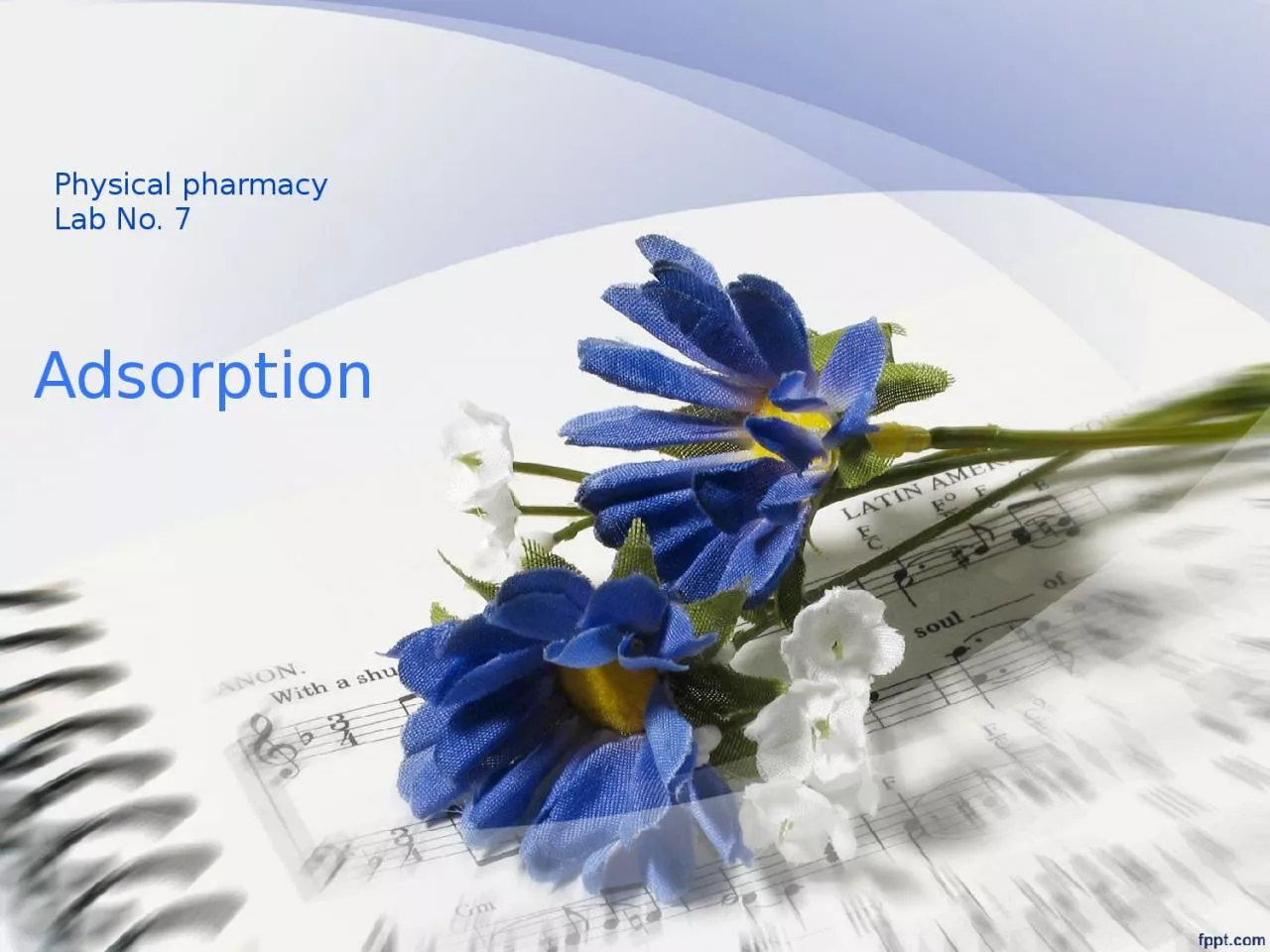

7 Adsorption Adsorption Adsorption is a process of free moving of solutes or gaseous molecules of a solution come close and attach themselves onto the surface of solid The adsorption can be strong or weak depends on the nature of forces between solid surface adsorbent and the gas or dissolve ID: 1021064
Download Presentation The PPT/PDF document "Physical pharmacy Lab No." is the property of its rightful owner. Permission is granted to download and print the materials on this web site for personal, non-commercial use only, and to display it on your personal computer provided you do not modify the materials and that you retain all copyright notices contained in the materials. By downloading content from our website, you accept the terms of this agreement.
1. Physical pharmacyLab No. 7Adsorption
2. AdsorptionAdsorption is a process of free moving of solutes or gaseous molecules of a solution come close and attach themselves onto the surface of solid. The adsorption can be strong or weak depends on the nature of forces between solid surface (adsorbent) and the gas or dissolves solute (adsorbate), as shown below:
3.
4. Adsorption
5. Types of adsorption:-1- physical or vanderwaals adsorptionassociated with vanderwaals force and it is reversible . the removal of adsorbate from adsorbent known as desorption ,as physically adsorbed gas can be desorbed from solid by increasing temperature and decreasing pressure.2- chemical or chemisorptionsin which adsorbate is attached to adsorbent by primary chemical bond and is irreversible
6. Type of adsorption
7. Application of adsorption:
8. factors affecting on adsorption processAdsorption on a solid is influenced by a number of factors such as,• Surface area• Nature of the adsorbate• Hydrogen ion concentration (pH) of the solution• Temperature• Mixed solutes and• Nature of adsorbent
9. Freundlich adsorption isothermfreundlich derived an empirical equation for the absorption of the dissolved solid on the surface of porous substance. x/m = k(Freundlich adsorption isotherm) or log x/m = log k + 1/n log Pwhere x is the weight of the gas adsorbed by m gm of the adsorbent at a pressure p, thus x/m represents the amount of gas adsorbed by the adsorbents per gm (unit mass), k and n are constant at a particular temperature and for a particular adsorbent and adsorbate (gas), n is always greater than one, indicating that the amount of the gas adsorbed does not increase as rapidly as the pressure.
10. according to freundlich equation a plot of log x/m versus log P a straight line obtained and the constant k and 1/n determined ( intercept = log k, slop = 1/n )Log C or
11. Experimental workAim of the experiment is to study the adsorption of oxalic acid on kaolin and see the effect of increasing the concentration of oxalic acid on adsorption. Materials and equipments:--oxalic acid, D.W., NaOH, kaolin-solutions:- 1 N oxalic acid,0.5 N NaOH, ph.ph indicator-volumetric flask (50 cc)conical flask , pipette (20 cc), filter paper ,funnel, burette.
12. Procedure :-1- prepare 50ml of the following concentration of oxalic acid ( 0.2 , 0.4 , 0.6 , 0.8 N ) from stock solution of 1N oxalic acid.2- put 50 ml of each concentration and stock solution in 5 conical flasks.3-introduce 2gm kaolin into each flask.4- shake for 15 min. ,set aside for another 15 min to achieve equilibrium. 5-filter, reject the first portion of the filtrate after washing the receiver with it .6- pipette 20 ml of the filtrate containing the non-adsorbed oxalic acid (free) and titrate them with 0.5 N NaOH using phenolphthalein indicator ( End point change in color from colorless to pink)7- calculate the amount adsorbed in each flask and plot freundlich adsorption isotherm , find the values of K and 1/n.
13.
14. Calculate the amount of total oxalic acid in each flask as follows:-flask no.1:- if there is no kaolin present and we take 20 ml of solution and titrate it with 0.5 N NaOH theoretically it take 40 ml NaOH 1mole oxalic acid = 2 mole NaOH1 M * V ox.A = 2 M * V NaOH2 N * V ox.A = 2 N * V NaOH1 * 20 = 0.5 * V V= 40 ml NaOH we need if there is no kaolin present in the flask40* 0.0315 = 1.26 gm oxalic acid /20 ml (total) = 3.15 gm ox.A /50 ml ...............................in flask no.1x=amount adsorbed = 3.15 -[ (E.P1 * 0.0315)*50/20]= gm/50ml adsorbed of oxalic acid (X)
15. repeat the calculation for the other 4 flasks to find amount of oxalic acid /50ml that is adsorbed- C% can be calculated as follows:-for flask no. 1 ( concentration = 1 N) 1 = wt*1000 / 63*100c%= 6.3 gm of oxalic acid /100mlrepeat the calculation for the other flasks to find C%
16. Tabulate the result as follow